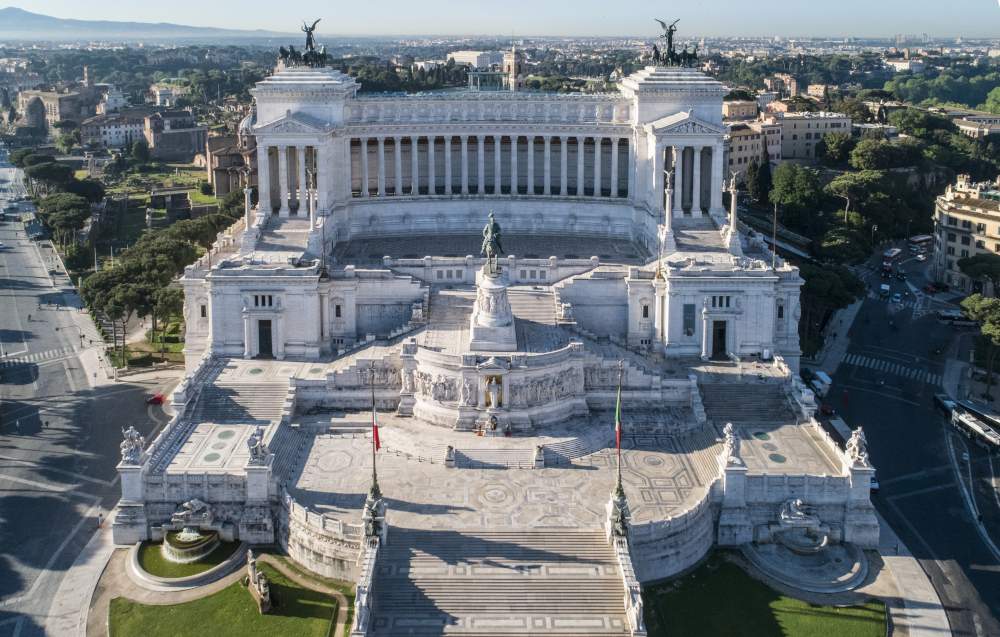From October 26, 2023 to February 25, 2024, the VIVE - Vittoriano and Palazzo Venezia presents in the Zanardelli Room of the Vittoriano the exhibition The Goddess Rome and the Altar of the Fatherland. Angelo Zanelli and the Invention of the Symbols of United Italy, curated by Valerio Terraroli, in collaboration with the Archivio Centrale dello Stato, the Soprintendenza speciale Archeologia, Belle Arti e Paesaggio di Roma and the Fondazione Brescia Musei.
The exhibition aims to celebrate the conclusion of the restoration campaign of the Altar of the Fatherland frieze created by Lombard sculptor Angelo Zanelli (San Felice di Scovolo, March 17, 1879 - Rome, 1942). Once the scaffolding is removed, the frieze will be visible to the public on the very day of the exhibition opening.
The exhibition project intends to reconstruct the events of the sculptural decoration of the Altar, from the 1908 competition to the popular referendum on the occasion of the inauguration of the Vittoriano in 1911 that led to Angelo Zanelli’s final victory, from the various stages of execution to the inclusion of the Tomb of the Unknown Soldier in 1921 to the placement of the statue of The Goddess Rome in 1925. The exhibition also aims to recount Zanelli’s artistic journey within Italian Symbolist culture, through some works that preceded the project for the Roman frieze, and the subsequent evolution of his language. The objective of the exhibition is then to explain how and why Zanelli’s frieze concurred, in one with Giuseppe Zanardelli’s political orientation, architect Giuseppe Sacconi’s design for the Vittoriano, and works by coeval sculptors such as Leonardo Bistolfi, Ettore Ximenes, and Arturo Dazzi to forge the symbols of united Italy, shaping the visual and value imagery of the new nation.
On display in the Zanardelli Hall will be plaster casts from the VIVE collections from the repositories, studied and restored for the occasion, works from the Zanelli bequest from the Brescia Musei Foundation and other testimonies from museum institutions and private collections.
The centerpiece of the exhibition will be the Goddess Rome, the central figure of the frieze itself, in axis with the equestrian monument of Victor Emmanuel II, and the visual focus of the entire Vittoriano, the origins and developments of its iconography and the influences this image has exerted over time.
At the end of the exhibitions there will finally be access to an immersive room, to let visitors literally enter the newly restored frieze, to admire it in great detail thanks to digital.
“After Bronze & Gold, this on Zanelli is the second focus exhibition promoted by VIVE,” said Edith Gabrielli, director of VIVE - Vittoriano and Palazzo Venezia. “For a long time not only Zanelli, but all sculptors active in the Vittoriano have been victims of a lack of critical understanding. The exhibition helps to change the meaning of things: it helps the public and - why not? - scholars, too, to get to know them better. A different and certainly positive picture emerges: we can thus say that the great frieze of the Altar of the Fatherland is thus definitively returned to the public and critics.”
Credit MIC, LIVE - Vittoriano and Palazzo Venezia.
 |
| At the Vittoriano an exhibition focus on the Goddess Rome and the Altar of the Fatherland |
Warning: the translation into English of the original Italian article was created using automatic tools. We undertake to review all articles, but we do not guarantee the total absence of inaccuracies in the translation due to the program. You can find the original by clicking on the ITA button. If you find any mistake,please contact us.